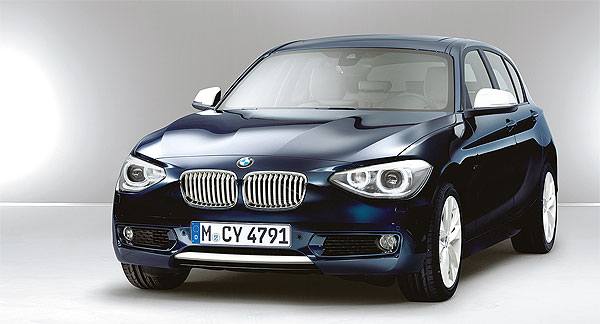
BMW’s baby hatch may look very similar to before, but it’s the engines that are making the news. – If it’s broke, shouldn’t it be fixed then?
True, the 1-series from BMW was largely unpopular in Thailand (see sidebar) but in Europe it’s a different storing, having proved itself a useful model in attracting entry-level buyers to BMW showrooms.
That explains the evolutionary looks of the second-generation 1-series, as seen in these first official pictures released this week.
The front lights are now sleeker in appearance (reflecting what you could be seeing in the next-gen 3-series, we hear), while the rear lamps are now of the increasingly popular LED type.
Since the first-gen 1-series had some packaging flaws, BMW has blown up the body in practically all dimensions with the exception of an unchanged height.
The 1-series is 85mm longer than before and 30mm more in wheelbase length to clearly maintain its premium C-segment status. These enhancements help liberate more rear legroom _ one of the weak points in the earlier hatchback.
The width has also grown by 17mm, although it’s the tracks that have grown significantly: 51mm up front and 72mm at the rear.
The interior sees plusher materials; rear legroom is said to be improved by 21mm; the rear LED lights are among the most distinctive details.
– To better ride comfort, right?
Right. The old days of stiff-riding Bimmers seem to be vanishing, with the latest one having dealt with the problem in a significant manner before the arrival of the new X3. Larger dimensions usually allow makers to introduce more ride comfort while maintaining the level of handling finesse needed of a sporty car like this BMW.
But in order to catch up with real-world demands of today’s drivers, BMW has ushered in some driver-assistance technologies found in more expensive luxury cars, you know, things like Lane Departure Warning and so forth.
There’s also an optional Variable Sport Steering to make driving at low speeds and during parking a doddle by yielding less steering effort and number of turns. A more conventional electro-mechanical setup is available for more focused drivers.
In fact, BMW stresses that the 1-series promises to be as sporty as ever to drive, and that’s why it’s still the only hatchback in the entire C-segment class _ mass-market players included _ to come in rear-wheel-drive form.
– Hey, I thought the 1-series was going to switch to FWD…
Yes, there’re reports suggesting the 1-series will eventually spawn a front-wheel-drive variant, probably for the pending three-door version that would be positioned lower down the luxury car market.
Top brass at BMW freely admit that front-drive Bee-ems would come, citing one market research that said many owners of the 1-series didn’t know which wheels the engine were driving.
Rear-drivers offer advantages of sportier handling but aren’t as cost-effective as front-drivers. As well, the need for a shaft running from the engine up front to the rear eats into cabin space, especially for the fifth occupant _ and this is still the case for the new 1-series, despite the front seats now being pushed further forward.
– Whatever. And what’s the novel engine?
There’s a new downsized 1.6-litre petrol-turbo inline-four with two outputs to choose from: 136hp/220Nm (116i) and 70hp/250Nm (118i).
With the help of direct-injection and twin-scroll turbo technologies (like in the Mini), these two petrol heads can achieve an average economy of 17.8kpl with the figure stretching to an Ecocar-like 21.3kpl on the highway (don’t forget: the figures quoted by Ecocar makers are the best ratings).
BMW’s eight-speed automatic now comes down to the 1-series replacing the old six-speeder. Eco-enhancers include the automatic stop/go and Eco Pro mode which reduces engine and air-con operation to promote economy _ like in Japanese cars fitted with Eco function.
– What about the diesels?
There’s a 2.0-litre diesel-turbo with three yields: 116hp/260Nm (116d), 143hp/320Nm (118d) and 184hp/380Nm (120d). All have practically the same fuel consumption: 22.7kpl on the average and a Toyota Prius-like 25kpl on the highway. It should also be noted that the 120d is faster than the petrol-powered 118i in the 0-100kph acceleration timed at 7.3sec.
– No wonder the Thai taxation is so flawed…
Yeah, we don’t need to say much again. But here’s something that might interest you. BMW is looking at building the 1-series in Thailand to make it the new entry-level BM _ after the X1 _ priced below 2 million baht (Mercedes is also pondering likewise with the next-gen A-class), as reported recently in Business Post.
Of course, such news won’t raise eyebrows of Ecocar owners. But for those who have a liking for posh wheels _ and needing green credentials to stay relevant _ the new 1-series is to be watched out for next year.
Article courtesy of bangkokpost.com

